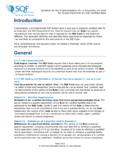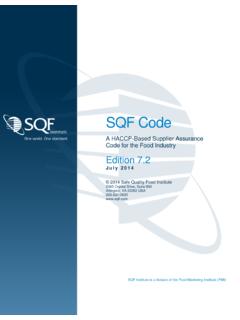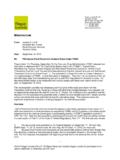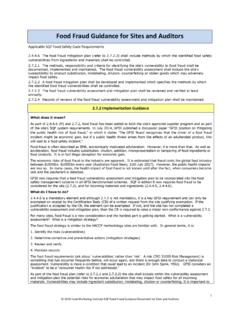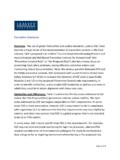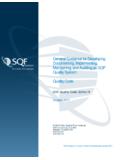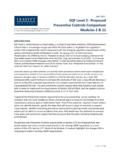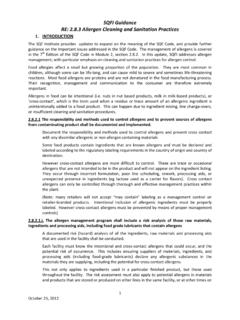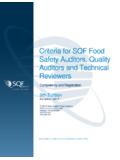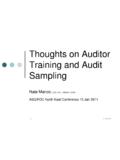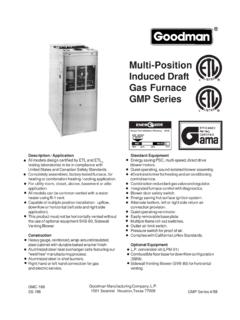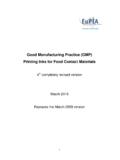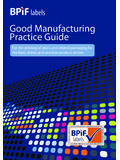Transcription of General Guidance for Developing, Documenting, …
1 General Guidance for Developing, Documenting, Implementing, Maintaining, and Auditing an SQF System Module 11: good manufacturing practices for Processing of Food Products SQF Code, Edition 8 N O V E M B E R 2 0 17 2017 Safe Quality Food Institute 2345 Crystal Drive, Suite 800 Arlington, VA 22202 USA 202-220-0635 SQF Institute is a division of the Food Marketing Institute (FMI). Preface This document provides General Guidance for SQF suppliers, consultants and auditors when implementing and auditing module 11 of the SQF Code, edition 8 and can be used where no specific industry sector Guidance is available. The purpose of SQF Code implementation is not only to achieve certification, but to assure constant and continual validate and review of a supplier s SQF System for currency and completeness. Effective implementation of the SQF Code requires the commitment of the site management and the constant involvement and participation of site staff to maintain the safety of SQF certified products.
2 The results of effective SQF implementation are not only the protection of public health and company brands, but real improvement in margins by reduction of waste, recalls and withdrawals, and improved productivity through doing it right the first time. The SQF Institute is grateful to the SQF Institute Technical Advisory Council and SQF stakeholders for their assistance in reviewing and contributing to this document. Guidance for Developing, Documenting, Implementing, Maintaining and Auditing an SQF System SQF Code, Edition 8 Module 11: good manufacturing practices for Processing of Food Products 2017 Food Marketing Institute 2 SQF Code Module 11 Guidance Document Table of Contents Preface .. 1 Section 1. Introduction .. 3 Purpose of the Guidance Documents .. 3 Layout of the SQF Code .. 3 Section 2. The SQF Certification Process .. 4 Section 3. The SQF Implementation Process .. 4 Section 4. Introduction to This Guide.
3 6 1. Purpose and Scope of This Guide .. 6 2. The Structure of the SQF Code, Edition 8 .. 6 3. The Structure of Module 11 .. 8 4. The Format of the Module 11 Guidance .. 9 Section 5. Guidance for good manufacturing practices for Processing of Food Products .. 10 Site Location and Construction .. 10 Construction of Premises and Equipment .. 11 Personnel Hygiene and 30 Personnel Processing practices .. 41 Water, Ice, and Air Supply .. 42 Storage and Transport .. 48 Separation of Functions .. 57 On-Site Laboratories .. 65 Waste Disposal .. 66 Exterior .. 67 Guidance for Developing, Documenting, Implementing, Maintaining and Auditing an SQF System SQF Code, Edition 8 Module 11: good manufacturing practices for Processing of Food Products 2017 Food Marketing Institute 3 SQF Code Module 11 Guidance Document Section 1. Introduction Purpose of the Guidance Documents The purpose of this series of SQF Guidance Documents is to assist suppliers with designing, developing, documenting, implementing and maintaining an SQF System using the SQF Code, edition 8, and to assist SQF registered auditors in auditing the SQF Code, edition 8.
4 The relevant Code version number is identified in the document header. Terms used in these documents are defined in Appendix 2: Glossary of the SQF Code edition 8. Guidance is intended to support the SQF Code, but does not replace it. It is not an auditable document, nor is it definitive and applicable in every situation. Suppliers, consultants, and auditors are required to understand the food safety risks in a given industry sector and are able to apply the SQF Code to effectively control those risks. Layout of the SQF Code The SQF Code, 8th edition consists of two parts and four appendices. Part A contains the criteria for implementing and maintaining the SQF Code. Part B, the heart of the SQF Code, is made up of modules. Within each module are clauses or elements, which the supplier must implement as their SQF System. In module 2, the clauses encompass the system elements. Each element outlines where procedures need to be documented, where record keeping is required or where actions must be taken.
5 Modules 3-15 are the good Agriculture, Aquaculture, manufacturing and Distribution practices (GAP/GMP/GDP) requirements applicable to various food industry sectors. Producers and suppliers must meet the requirements of the module or modules applicable to their food industry sector. The four appendices in the SQF Code provide additional information needed to implement an SQF System: o Appendix 1: SQF Food Sector Categories o Appendix 2: Glossary of Terms o Appendix 3: SQF Logo Rules of Use o Appendix 4: Requirements for SQF Multi-site Certification Guidance for Developing, Documenting, Implementing, Maintaining and Auditing an SQF System SQF Code, Edition 8 Module 11: good manufacturing practices for Processing of Food Products 2017 Food Marketing Institute 4 SQF Code Module 11 Guidance Document Section 2. The SQF Certification Process The steps for the process of preparing for SQF certification are shown below.
6 Optional steps or other options are indicated in parenthesis. This process is outlined in section 1 of Part A of the SQF Code, 8th edition. Section 3. The SQF Implementation Process To achieve SQF certification, the supplier must document and implement the relevant modules of the SQF Code, at the level required. It s also important to provide evidence of the System in the form of documents and records. The implementation process is shown below. Step 1 Learn about the SQF Code (SQF Implementation Training) Step 2 Select the relevant SQF modules Step 3 Register in the SQF assessment database Step 4 Designate an SQF practitioner Step 5 Document and implement the SQF Code Step 6 Select a certification body Step 7 (Conduct a pre-assessment audit) Guidance for Developing, Documenting, Implementing, Maintaining and Auditing an SQF System SQF Code, Edition 8 Module 11: good manufacturing practices for Processing of Food Products 2017 Food Marketing Institute 5 SQF Code Module 11 Guidance Document Document the SQF System prepare policies, procedures, work instructions and specifications that address the relevant modules of the SQF Code.
7 In other words say what you do. Implement the SQF System put into place the prepared policies, procedures, work instructions and specifications. In other words, do what you say. Provide records the SQF System keep records to demonstrate compliance to the relevant modules of the SQF Code. These records provide evidence of the function and control of the System. In other words, prove it. Guidance for Developing, Documenting, Implementing, Maintaining and Auditing an SQF System SQF Code, Edition 8 Module 11: good manufacturing practices for Processing of Food Products 2017 Food Marketing Institute 6 SQF Code Module 11 Guidance Document Section 4. Introduction to This Guide 1. Purpose and Scope of This Guide The purpose of this series of SQF Guidance Documents is to assist suppliers with designing, developing, documenting, implementing and maintaining an SQF System using the SQF Code, edition 8, and to assist SQF registered auditors in auditing the SQF Code, edition 8.
8 The relevant Code version number is identified in the document header. Terms used in this document are defined in Appendix 2: Glossary of the SQF Code, edition 8. This particular guide covers the requirements of Module 11: Food Safety Fundamentals good manufacturing practices for Processing of Food Products. It covers the good manufacturing practices requirements for the processing of perishable animal products, and production of bio-chemicals. Suppliers implementing this module must also meet the requirements of Module 2: SQF System Elements. Module 2 Guidance is a separate document and suppliers are advised to understand the System Elements, , the requirements of Module 2 before addressing Module 11. Applicable food sector categories (FSCs) for Module 11 are: FSC 8 Processing of manufactured meats and poultry FSC 9: Seafood processing FSC 10: Dairy food processing FSC 11: Apiculture and honey processing FSC 12: Egg processing FSC 13: Bakery and snack food processing FSC 14: Fruit, vegetable, and nut processing, and fruit juices FSC 15: Canning, UHT and aseptic operations FSC 16: Ice, drink, and beverage processing FSC 17: Confectionery manufacturing FSC 18: Preserved foods manufacture FSC 19: Food ingredient manufacture FSC 20: Recipe meals manufacture FSC 21: Oils, fats and the manufacture of oil or fat-based spreads FSC 22: Processing of cereals, grains, and nuts FSC 25: Repackaging of products not manufactured on site FSC 31: Manufacture of dietary supplements FSC 33: Manufacture of food processing aides Guidance is intended to support the SQF Code, but does not replace it.
9 It is not an auditable document, nor is it definitive and applicable in every situation. Sites, consultants, and auditors are required to understand the food safety risks in a given industry sector and are able to apply the SQF Code to effectively control those risks. 2. The Structure of the SQF Code, Edition 8 The SQF Code is a process and product certification standard that uses Hazard Analysis Critical Control Points (HACCP) as its foundation. HACCP is a food safety management system based on the principles defined in either: The CODEX Alimentarius Commission HACCP principles and guidelines, or The National Advisory Committee on Microbiological Criteria for Food (NACMCF) The main feature of the SQF Code is its emphasis on the systematic application of HACCP to identify, monitor and control food safety hazards hazards in the process flow to manage identified food safety risks. Guidance for Developing, Documenting, Implementing, Maintaining and Auditing an SQF System SQF Code, Edition 8 Module 11: good manufacturing practices for Processing of Food Products 2017 Food Marketing Institute 7 SQF Code Module 11 Guidance Document This guide references the HACCP (Hazard Analysis and Critical Control Point) technique but does not explain the HACCP method in any detail.
10 It requires that those implementing and auditing an SQF System to have completed HACCP training as defined in Appendix 2: Glossary of the SQF Code, edition 8 and have extensive knowledge of the HACCP guidelines of either of the above documents, the application of the HACCP principles and experience in implementing HACCP systems. It is not meant to deliver prescribed, absolute rules for implementation, but to be utilized by suppliers, SQF consultants and SQF auditors as recommendations on practical applications for implementation and certification of the SQF Code. The SQF Code also recognizes that food safety practices differ depending on the food safety risk to the product or process, and has designed the Code to meet the individual requirements of each industry sector. Modules 3 through 15 prescribe the good Agricultural practices , good Aquaculture practices , good manufacturing practices , or good Distribution practices that may apply to particular industry sectors.
